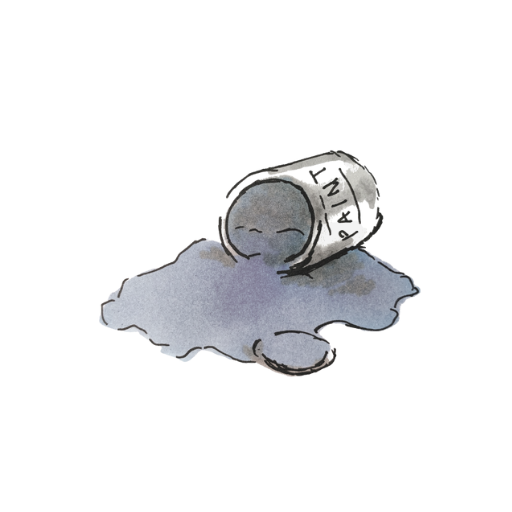
When I had Leo, like all new mums, I spent hours lying in bed feeding him. During this time, I grew to hate my bedroom. I had never been completely happy with the pale yellow walls, but now that I was spending so much time in there – in the dark – the colour really wore on me. It made me stressed and restless. It looked sickly and insipid and I would often end up in the spare room simply so that I didn’t have to look at the walls. This time made me really start to think about colour differently and I began reading more and more about colour psychology. This blog explores what I have learnt so far about colour psychology at home.
Colour psychology hugely interesting topic and I can highly recommend this pocket book by Karen Haller, which first sparked my interest in the subject. Karen’s blog can be found here and you can follow her on Instagram here.

So my bedroom was yellow. It was an accidental decision. We picked out a neutral magnolia-ish colour mostly to match the cream carpets and without any actual thought. Oli then did an excellent job of painting the bedroom and he was rightly proud of his efforts. This is partly why the room remained a colour I just didn’t like for so long; I felt a bad for not liking it, given how much work went in to painting it. The bedroom was horrible when we bought the house and so we needed to spruce it up quickly, which is why not a lot of care went into the colour planning initially.
Learning about Colour Psychology at home
The more of Karen’s book I read, the more interested I became, and I was fascinated to discover that the feelings I had developed toward my yellow walls were not all that unusual.
If asked to describe ‘yellow’ as a mood, you might come up with words such as ‘happy’, ‘joyful’, ‘uplifting’ and so on (the former being the most popular choice when I put this challenge out to my Instagram followers), so it really surprised me to read that as well as these associations, there are also the negative ones: being enveloped in a room the wrong tone of yellow can induce feelings of anxiety and even depression. So my feelings of stress and misery and restlessness were, in fact, quite normal.
Redecorating for mental health
Happily, new mums tend to win the arguments about redecorating, and so Oli let me go for a bold new scheme – a monochromatic navy blue room – which couldn’t be further from the pale yellow it once was. The room isn’t quite finished yet, but here it is as a work in progress:

It’s funny because I got a daft comment on Instagram saying the room was horribly dark and I’d wake up miserable to dark mornings. Although this sort of comment is totally unnecessary, it has given me many a chuckle, because it couldn’t be further from how I feel. Yes, I have painted the bedroom much darker colour, but actually this room, with its huge bay window is wonderfully bright in the morning and in the late afternoon, being west-facing, as the sun comes over it becomes filled with golden light turning the room a warm, indigo blue. It’s deep and rich and at night when I go to bed it feels cosy and like I’m going to sleep in a hug. I couldn’t love the colour more!
Colour is subjective
How we feel about a certain colour and even how we see that colour is subjective. It’s for this reason that it thoroughly annoys me whenever I hear people saying a certain colour is ‘boring’ and that people should be ‘braver’ with their colour choices. No colour is boring; if it makes you happy and you feel at ease and comfortable, then that isn’t a boring colour, it is the perfect colour. As for being brave, this is a bit different and something I am learning I can be, now I understand more about the colours that work for me.
For example, it would probably be considered ‘brave’ to paint my dining room bubblegum pink. I’d get lots and lots of likes. However, given that I really don’t like bubblegum pink, it would not be so much a brave decision as a rather daft one.
I should say that I don’t hate ‘pink’. In fact, I am quite tempted to paint our kitchen cabinets in ‘Setting Plaster’ from Farrow & Ball. It’s pink, but a duller, more salmony pink. Some people would hate this colour, but me, I hate bubblegum. We are all different and that’s not just fine, but wonderful, because in fact what would actually be boring is if we all liked the same thing and had carbon copies of each others’ houses.

Colour Psychology at home – how to decorate
This is a huge topic in its own right, and one that I plan to write about as I myself learn more. But first and foremost, we need to decorate for the people we are not the people we aspire to be or think we ought to be. That doesn’t mean to say we can’t be ‘braver’ with our colour choices, but rather than going for bubblegum, I went for my deep, dark blue in the bedroom. Still a brave choice, but one that works for me and brings me joy. I quite like the idea of being someone who loves brightly coloured ceilings, because I think they ooze cool, but I also know that lying in bed, gazing up at a turquoise ceiling, I’d never get any sleep.
Four seasons of colour
In The Beginner’s Gide to Colour Psychology, Angela Wright identifies four distinct colour palettes that follow the seasons.
Spring
Spring is light, bright, airy and clear. The colour palette for spring has no black. The colours are fresh and their clarity comes from their lack of grey.

In colour psychology, the Spring personality is fun, spirited and outgoing. I’d probably describe these people as ‘bouncy’! Springs are spontaneous and carefree party planners. They enjoy the simple things in life and like being close to nature. Spring personalities are more inclined to pack up a picnic and camp under the stars than head out for a spot of fine dining or a night at the ballet. They like all the cutsie things in life and probably own something from Cath Kidston.
Summer
Summer’s palette is also light, but whereas Spring is all about clarity, the shades of summer are dulled with grey. I think the classic Farrow & Ball colour card falls fairly neatly into the summer camp and these tones are soft, understated and elegant.

Colour psychology tells us that summer personalities are a little more introverted than springs. They are cool and calm and the palette is correspondingly soft, muted and gentle. Summers like for everything to be thought-through and considered; everything has its place. They are organised and prefer to avoid the limelight. Summers are demure characters and ooze effortless, understated elegance. Summer would be more likely seen at the Royal Albert Hall than a busy nightclub.
Autumn
Autumn is an earthy palette. This is a time of year when the leaves are turning and I always think of log fires and hot chocolate. The colours of autumn reflect this. They are rich, warm and wholesome; think olive greens and mustardy yellows.

Autumn personalities are colour psychology’s warm and jolly types. I imagine those cheerful dog-walkers who always give me a wave at the park (I haven’t a clue who they are, but I like them). Autumn people love a Sunday roast with plenty of red wine and friends gathered round for an afternoon of chatter. Followed maybe by a walk with those dogs in the woods. Autumn is earthy and grounded, so these personalities like being outdoors and prefer a laid back catch up with friends over a fancy, formal affair. They are outgoing types and probably have lots of books and photos of family dotted about the house.
Winter
Winter’s palette is the only one to contain pure black and white. It’s bright and cool. Winter colours are modern and bold.

Winter personalities are colour psychology’s cool elite. They could potentially come across as a bit aloof, but they just like everything to be precise and neat. Winters mean business! As this is the only palette to feature black and white, winters often like sharp lines and contrasting colours. They are driven, high-maintenance and super-sophisticated. I imagine high-fliers in expensive suits and a pair of Louboutins. Winters will know all the best places in town (and probably someone who can get you ahead on a waiting list). When you go out with winter, you can bet it will be somewhere flash. They are careful with money, but like to buy once and buy well and they don’t love clutter.
Which personality type are you?
There’s personality tests you can do to see which season you slot into and most of us have a predominant season and then a secondary one. For me, boring old summer (I’m being facetious) is my predominant season and I have a dose of autumn thrown in too.
The right colour; the wrong room

One thing I think it’s worth remembering, is just because a colour appears in the palette of the season you’re most aligned with, it doesn’t necessarily mean you should throw it around any which way.
Take me and yellow, for example. My kitchen basically beige and that slots into the yellow category, but I don’t feel anxious and stressed in the kitchen like I did in the bedroom. In this room, east-facing and bathed with morning sun, my yellow walls fill me with joy in the morning. I just wouldn’t want to sleep in the kitchen.
Using colour psychology at home
Once you have established the palette to best suit your personality, you may feel more comfortable going with the ‘braver’ (usually darker, bolder) colours within your palette. A year ago I would have told you I really didn’t like ‘dark’ interiors, but my bedroom is now my favourite room, because it’s the right shade of dark blue for me.

Also, once you have a palette in mind, making design choices from paint colours to new plant pots, will become easier and you’ll naturally begin to develop a harmonious scheme throughout the house.
One thing I did when we first started decorating was throw every design idea I liked at the house. Rooms were disjointed; we had busy wallpapers that I just did not like looking at and there was one particular frame in the living room that never looked quite right. I eventually realised it was because the frame was a cool grey and against the warm grey walls, it was jarring.

I don’t think colour psychology at home should be taken as some kind of gospel you must follow, but it’s good fun as a starting point, and something I’ll be exploring more throughout my colour psychology blogs. I’ll be looking more closely at specific colours, the moods commonly associated with them and how they can work at home.
I am still learning about colour psychology at home, but I hope you’ll enjoy learning with me.
Enjoyed this blog? Sign up by email!
Get blog notifications, DIY guides, exclusive discounts and all the interiors chat direct to your inbox when you sign up. Pop your details in below and you’ll receive the weekly newsletter.
Pin this blog for later!





Really interesting, thanks! Just from looking at the palettes I’d say I’m a summer too but going to find a test to do! Looking forward to your next colour post 😊 x
Looking forward to the next instalment. I like to experiment with but I always come back to summer colours.